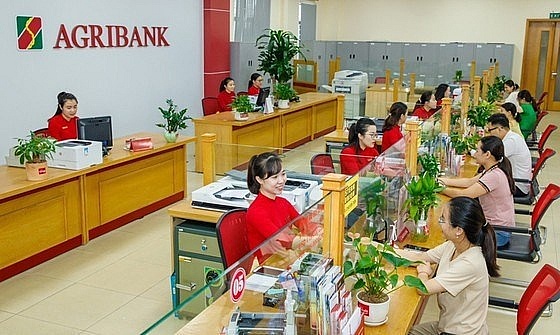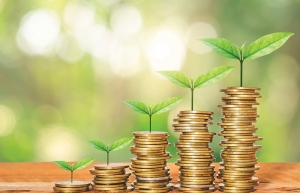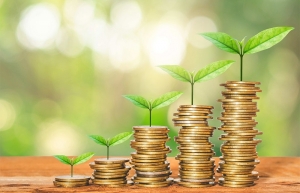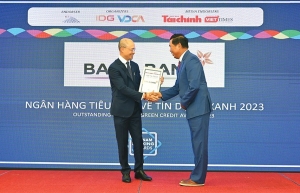Banks join in promoting green credit
 |
| Commercial banks in Vietnam have been actively offering loans for green projects. (Photo: sggp.org.vn) |
Hanoi - Commercial banks in Vietnam have been actively offering loans for green projects and expanding green credit through mobilising capital from international credit institutions.
Green credit has been given more and more attention, especially after 2012 when the Government approved the National Strategy on Green Growth, and green credit and green banking has been made a major orientation in the banking sector's development strategy to 2025 with a vision to 2030.
VietCapital Bank offered a preferential credit package worth 300 billion VND (nearly 12.46 million USD) to support businesses converting to green production models.
The bank has also added 500 billion VND to a green credit package with a preferential interest rate of 8.9 per cent per year to lend to inpidual and business customers engaging in farming activities that apply technology or models following VietGAP, GlobalGAP standards and organic farming.
Recently, Vietcombank has also granted 4 trillion VND in both medium and long-term credit to PetroVietnam Electricity Corporation to finance the Nhon Trach 3 and 4 Power Plant projects in Nhon Trach district, Dong Nai province.
In March, Vietcombank and the Japan Bank for International Cooperation (JBIC) signed a cooperation agreement worth 300 million USD, adding capital to support renewable energy projects.
Nam A Bank also eyed providing green credit to projects of electrical vehicles, renewable energy, and clean energy. It has just signed a cooperation agreement with the Global Climate Cooperation Fund (GCPF) to deploy a green credit programme that provides preferential financing for environmentally-friendly consumption and production. Currently, Nam A Bank's green credit balance is up to hundreds of billions of VND.
Since 2017, the Military Commercial Joint Stock Bank (MB) has been lending to renewable energy projects. Currently, about 8 per cent -10 per cent of the bank's total outstanding loans are for green credit areas. MB aims to increase the proportion of green credit and credit for technology transformation to 15 per cent of total outstanding loans by 2026.
Meanwhile, the Joint Stock Commercial Bank for Investment and Development of Vietnam (BIDV)'s green credit outstanding balance at the end of 2022 was at 63.8 trillion VND, accounting for 4.3 per cent of total bank loans and 13 per cent of total green loans in Vietnam. BIDV also committed to expanding the loan portfolio for green and sustainable fields by 2025, which is expected to reach 3 billion USD, accounting for about 5 per cent of BIDV's total outstanding loans.
To facilitate the growth of green credit, the State Bank of Vietnam (SBV) issued an action plan to implement the National Strategy on Green Growth for the period 2021-2030 and a project on tasks and solutions to implement the results of the COP26 conference.
Currently, 39 credit institutions are providing green capital with a credit growth rate of more than 25 per cent per year, higher than the average credit growth rate of the general economy.
However, the proportion of green credit is still very modest with outstanding green credit debt, at more than 500.5 trillion VND, accounting for just 4.32 per cent of the total outstanding debt of the entire economy.
Explaining the modest amount of green credit, a representative of the Department of Credit for Economic Sectors under the SBV said that the main reason is that there are no national regulations on criteria and lists of green projects for industries and fields as a basis for credit institutions.
The supervision and risk management when granting green credit still has problems due to the lack of regulations and criteria for evaluating projects' impacts on the environment.
In addition, investing in green industries and fields, especially in renewable energy and green buildings, often requires a long payback period, and large investment costs, which makes it difficult for banks to balance capital and ensure the ratio of short-term capital for medium and long-term loans as prescribed.
According to experts, if Vietnam has a standardised management framework, and a clearer definition of green projects, international banks can support the Vietnamese Government in promoting the green economy.
 | Top institutions seek green credit answers International organisations and financial institutions are waiting for specific criteria for green projects to unlock financing flows that can support deployment of green and sustainable initiatives. |
 | Green credit initiatives urged to push ahead development Given stringent domestic capital mobilisation, Vietnam’s banks are turning into international financial institutions for growth expansion, particularly to strengthen their sustainable and environmentally friendly loan portfolios. |
 | Green credit initiatives highlight positive advances New insights have been revealed into the sustainable debt market in Vietnam and ASEAN more broadly, showing diversification and government support for sustainable finance. |
 | Greener credit headlining BAC A BANK’s modernisation For nearly 30 years, BAC A BANK has been underlining the importance of nurturing sustainable development via its green credit activities and taking good care of its staff. |
What the stars mean:
★ Poor ★ ★ Promising ★★★ Good ★★★★ Very good ★★★★★ Exceptional
Related Contents
Latest News
More News
- Gold market reform advances as SBV receives applications for bullion production (December 30, 2025 | 12:07)
- EVN and AFD sign credit agreement for Vietnam’s first pumped storage hydropower plant (December 30, 2025 | 10:06)
- Techcombank Priority Visa Signature unlocks a higher standard of living (December 29, 2025 | 16:44)
- Tax sector wraps up 2025 and sets priorities for next year (December 25, 2025 | 14:00)
- A tipping point for digital and hybrid wealth management in Vietnam (December 23, 2025 | 13:33)
- $250 million deal targets women-owned SMEs, sustainable agriculture (December 22, 2025 | 17:40)
- Stock market posts resilient 2025 performance (December 19, 2025 | 18:17)
- Citi Vietnam receives 2025 AmCham CSR recognition (December 19, 2025 | 16:35)
- As global green supply chain reshapes, will Vietnam be left behind? (December 19, 2025 | 08:00)
- Banks gear up for massive capital increases (December 18, 2025 | 17:04)

 Tag:
Tag:




















 Mobile Version
Mobile Version